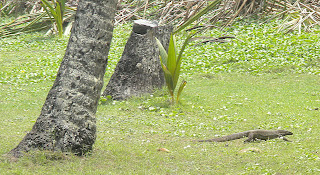Eighteen turtle hatcheries along the south coast of Sri Lanka do what they can to protect them. One special one is near my hotel.
The day I arrived, a young man met me on the beach and offered to take me to visit it the next morning. He arrived at the reception desk when I was finishing a long and lazy breakfast. The pleasant lady at the restaurant came to tell me.
“Your tuk tuk is waiting, Mum.”
And off I went.

It’s not easy being a sea turtle. Only 5% of the eggs that hatch are females. Some turtles are born blind or deformed and cannot survive. Numerous healthy babies are eaten by fish or other turtles – including their own mother. And men catch the adults for food or their shells. This has been illegal for years, but it still goes on.
The hatchery I visited is the passion of a Kosgoda fisherman called Chandrasiri Abrew (Chande for short).

He employs 40 local people to help him save as many turtles as possible. Chande belongs to the community, knows all the villagers and pays them for each turtle egg they bring him. He gets this money mainly from tourists like me who visit his hatchery.
My tuk tuk driver and guide explained things to me step by step.
Turtle eggs have squishy shells

so they do not break when the females come ashore and lay them in a hole they dig in the sand.
When eggs are brought to the hatchery, the employees rebury them just as their mother did the first time.

Each nest is marked to show the species of turtle. (OR stands for Olive Ridley, the smallest of the Sri Lankan sea turtles).
The eggs stay in the nest until they hatch. The top layer of eggs hatches in 48 days, the second layer two days later and the bottom layer in 52 days.
The baby turtles are put in tanks. After three days, they look like this.


The three day old turtles are released in the evening onto dry sand near the sea. During their slow journey towards the water, they somehow imprint the sand of this particular area of beach and, should the females survive, they come back to the same place once a year to lay their eggs.
This is the part of Sri Lanka that was devastated by the tsunami in 2004. Chande escaped with one albino turtle he had kept since they cannot live in the wild.

The entire hatchery was destroyed along with much of the village. Though most of the area has been rebuilt now, you can still see small areas here and there that give you a glimpse of the horror.

When Chande and his turtle returned, he set about rebuilding with the help of his tourist friends. He invited them to sponsor a tank. In thanks, he painted their names and country of origin on each one.

Saving endangered species seems a daunting task. But Chande’s doing it one egg at a time. I’m glad we met.











































